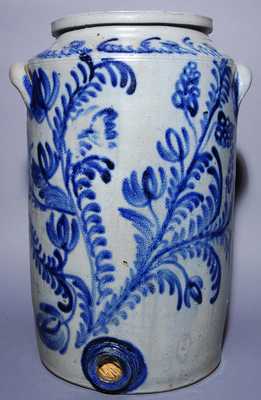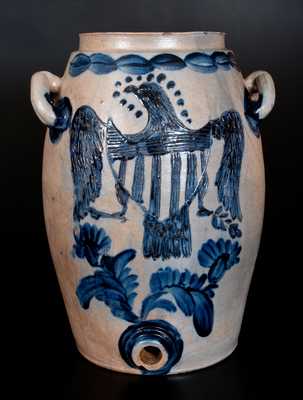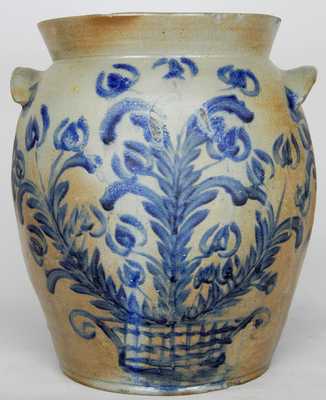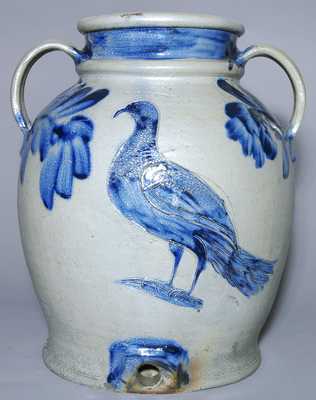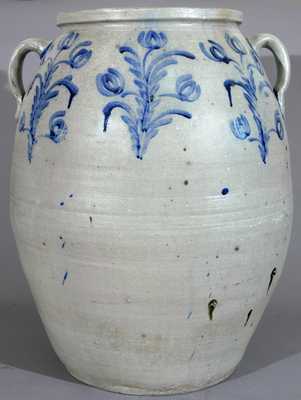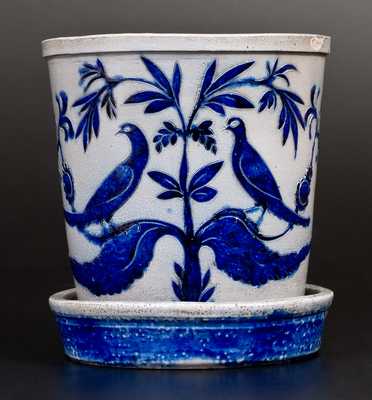Highly Important Four-Gallon Stoneware Water Cooler with Incised Grouse and Profuse Cobalt Floral Decoration, Stamped "H. MYERS," Henry Remmey, Sr. at Henry Myers's Baltimore Stoneware Manufactory, Baltimore, MD, circa 1821-1829, stylishly-potted, ovoid cooler with footed base, rectangular bunghole, tall collar with rounded moldings, and two thin strap handles applied at the shoulder. Front of cooler decorated with a large incised and cobalt-highlighted design of a grouse perched on a stylized leaf, embellished throughout with numerous impressed, semi-circular stamps simulating the bird's natural feathering. Broadly-brushed, fan-shaped floral motifs in the distinctive style of merchant Henry Myer's Baltimore Stoneware Manufactory extend from the terminals of the handles, flanking the grouse. Reverse decorated with a boldly-brushed, flowering garland in the same style, extending from handle to handle below a band of swags. Collar highlighted completely in cobalt between its upper and lower rounded moldings. Additional cobalt highlights to bunghole and handle terminals. Among the definitive examples of Southern incised or Remmey family stoneware known, this over-the-top work reveals the potter's mastery of the medium on all levels--potting, decorating, and firing. The quality of this object can be largely attributable to the Manhattan training brought by Henry Remmey and his son, Henry Harrison Remmey, to Baltimore. Henry Myers, the businessman who hired the father and son duo to produce his ware, even took note to mention these two craftsman by name and their city of origin in his advertisements. In our opinion, pieces produced during the Remmeys' tenure in Baltimore represent the zenith of American stoneware production from an artistic perspective. Incised bird and floral motifs are remarkably elaborate, deft, and detailed, and the color of the fired products--both clay and applied cobalt slip--were exceptionally vivid. The Remmeys managed to compete with their contemporaries, the Parrs- themselves known for extravagant cobalt brushwork- by lavishly decorating their well-fired ware with an unusually wide brush, as seen on this work. During this time period, an appealing new aesthetic was also brought to the forefront of the stoneware industry, one which is on full display on this cooler: a melding of incised motifs and brushed cobalt floral elements on the same object. The Remmeys' tenure at the Myers's Baltimore Stoneware Manufactory, spanning the years 1821 to 1829, would have a significant influence on the Southern and Mid-Atlantic stoneware industry for years to come. Design elements established there would become part of the decorative lexicon of potters in Philadelphia (where the Remmeys later established a long-standing pottery) and as far south as Edgefield, South Carolina. One of Edgefield's most influential potters, Thomas Chandler, began his career in Baltimore. An extraordinary churn with incised farm scene, bearing the inscription, "Thomas M. Chandler / Maker / Baltimore August / th 12 / 1829," was likely made at Myers pottery within years of the Remmey grouse churn. Currently on display at MESDA's Mariner Gallery, the churn features distinctive color, brushed swags at the shoulder matching those found on this cooler, and related floral motifs, that all but confirm this notion. By 1840, Myers pottery floral motifs, as seen on this lot, had become a part of the Edgefield style, adorning alkaline-glazed pieces made by Chandler and others at Phoenix Factory, exchanging cobalt for iron slip. The import of the Remmey grouse cooler, both as an object of extreme beauty and one which serves as the quintessential link between Northern and Southern potting traditions, cannot be overstated. A catalog cover lot in our very first auction in 2004, this cooler set a then-auction-record for Baltimore stoneware, also reaching a top-ten auction price at the time for American cobalt-decorated stoneware. Literature: Illustrated in Wingard, "From Baltimore to the South Carolina Backcountry: Thomas Chandler's Influence on 19th-Century Stoneware," Ceramics in America 2013, fig. 48. Provenance: Crocker Farm, Inc., July 17, 2004, lot 46; a prominent Mid-Atlantic collection. Excellent condition. Glazed-over firing flaw on rear, several base chips on rear and one minor base chip on front. H 15".













